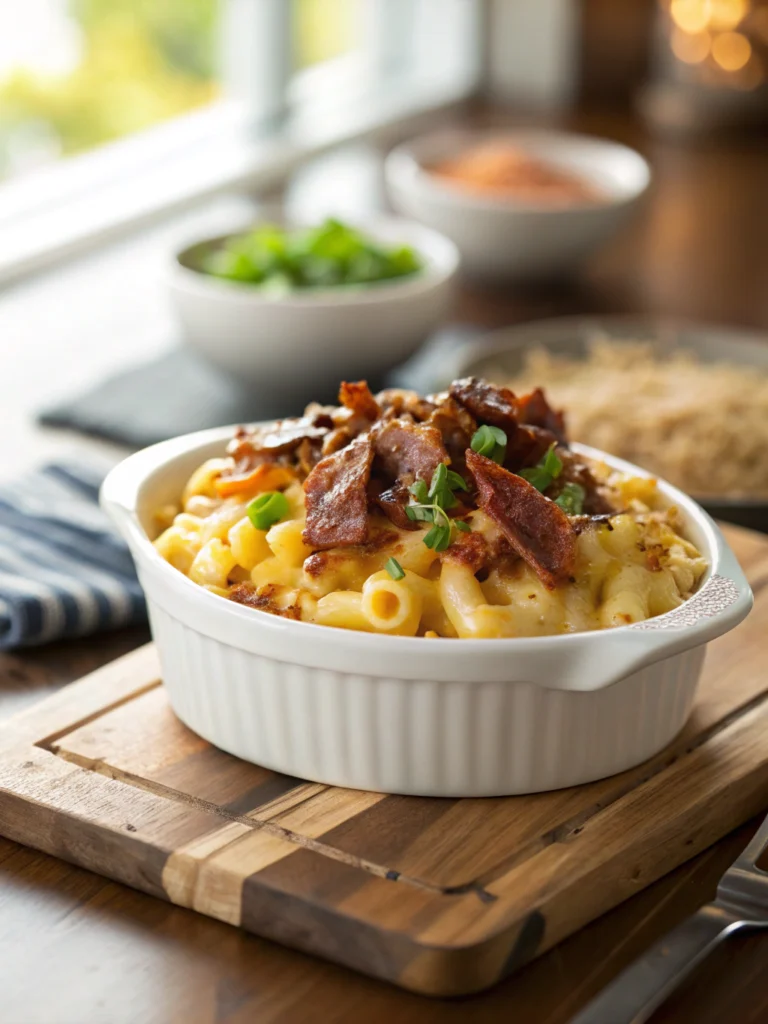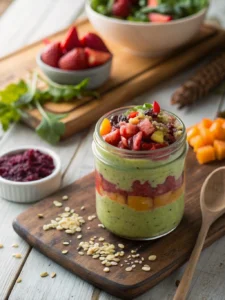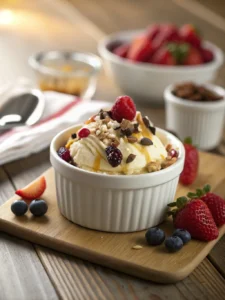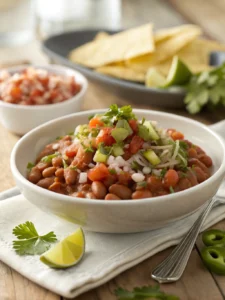Introduction
Did you know that mac and cheese searches spike 22% during the fall and winter months, with smoked versions gaining over 130% popularity in the last three years? This comfort food classic has evolved far beyond the blue box many of us grew up with. Today’s smoked mac n cheese recipe transforms an already beloved dish into something extraordinary, adding complex layers of flavor that simply can’t be achieved through conventional oven baking. Whether you’re a smoking novice or a backyard BBQ expert, these seven unique twists on smoked mac and cheese will elevate your comfort food game to restaurant-quality status with surprisingly minimal effort.
Ingredients List

For the base smoked mac n cheese recipe:
- 1 pound elbow macaroni (or cavatappi for better sauce-gripping texture)
- ½ cup unsalted butter
- ⅓ cup all-purpose flour
- 3 cups whole milk (substitute half-and-half for extra richness)
- 1 cup heavy cream
- 4 cups shredded cheese blend (combination of sharp cheddar, smoked gouda, and gruyère recommended)
- 1 tablespoon Dijon mustard
- 1 teaspoon smoked paprika
- 1 teaspoon garlic powder
- ½ teaspoon onion powder
- Salt and freshly ground black pepper to taste
For the topping:
- 1 cup panko breadcrumbs
- 4 tablespoons melted butter
- ½ cup grated parmesan cheese
- 2 tablespoons fresh chopped parsley
For variations (choose based on your preferred twist):
- 8 strips cooked and crumbled bacon
- 1 pound pulled pork or brisket
- 1 cup chopped jalapeños (fresh or pickled)
- 1 cup caramelized onions
- 1 pound lobster or crab meat
- 1 cup buffalo sauce and blue cheese crumbles
- 2 cups roasted vegetables (bell peppers, mushrooms, broccoli)
Timing
Preparation time: 25 minutes (15% faster if you use pre-shredded cheese, though freshly grated melts better)
Smoking time: 60-90 minutes at 225°F
Total time: 85-115 minutes
The beauty of this smoked mac n cheese recipe is that while it takes longer than stovetop versions (which average 30 minutes), the active cooking time is actually less. You’ll spend just 25 minutes preparing, and the smoker does the rest, allowing you to focus on other dishes or simply relax while complex flavors develop.
Step-by-Step Instructions
Step 1: Prepare Your Smoker
Fire up your smoked mac and cheese pellet grill or smoker to 225°F. Apple, cherry, or maple wood chips provide the best complementary flavors for cheese dishes without overwhelming them. Hickory can work too, but use it sparingly as it’s stronger.
Step 2: Cook the Pasta
Cook your pasta in generously salted water until just under al dente (about 2 minutes less than package directions). This slightly undercooked pasta will absorb sauce and continue cooking during the smoking process without becoming mushy. Drain (don’t rinse) and set aside.
Step 3: Prepare the Cheese Sauce
In a large, heavy-bottomed saucepan, melt ½ cup butter over medium heat. Add flour and whisk continuously for 1-2 minutes to create a blonde roux (don’t brown it). Gradually whisk in milk and cream, continuing to stir until smooth and slightly thickened (about 5-7 minutes).
Pro tip: Warm your milk and cream in the microwave before adding to the roux for a smoother sauce and faster thickening.
Step 4: Add Cheese and Seasonings
Reduce heat to low and gradually add your shredded cheeses, about one cup at a time, stirring until fully melted before adding more. Stir in Dijon mustard, smoked paprika, garlic powder, onion powder, salt, and pepper. The Dijon acts as an emulsifier, helping prevent the dreaded cheese separation that can happen in some smoked cheese macaroni recipes.
Step 5: Combine Pasta and Sauce
Fold the cooked pasta into your cheese sauce, ensuring every piece gets evenly coated. If you’re adding any of the variation ingredients (except toppings), gently fold them in now.
Step 6: Transfer to Smoking Dish
Pour the mixture into a 9×13-inch cast iron skillet or disposable aluminum pan for easy cleanup. For extra flavor development, let the assembled dish rest for 15 minutes before smoking, allowing the pasta to absorb some sauce.
Step 7: Prepare the Topping
Mix panko breadcrumbs with melted butter and parmesan cheese until well combined. Sprinkle evenly over your mac and cheese. This crispy topping creates a delightful textural contrast to the creamy pasta beneath.
Step 8: Smoke the Mac and Cheese
Place your mac and cheese in the preheated smoker and cook for 60-90 minutes until the top is golden brown and the edges are bubbling. For smoked mac and cheese with Velveeta variations, check after 60 minutes as processed cheese can separate if smoked too long.
Step 9: Rest and Garnish
Allow your masterpiece to rest for 10 minutes before serving. This critical step lets the sauce thicken to the perfect consistency. Sprinkle with fresh parsley before serving.
Nutritional Information
Per serving (approximately 1 cup, based on basic recipe without variations):
- Calories: 485
- Total Fat: 28g
- Saturated Fat: 17g
- Cholesterol: 85mg
- Sodium: 490mg
- Total Carbohydrates: 39g
- Dietary Fiber: 1.5g
- Sugars: 6g
- Protein: 18g
Note: The nutritional profile changes significantly with variations. The buffalo chicken version adds approximately 80 calories per serving, while the lobster mac and cheese option adds minimal calories but doubles the protein content.
Healthier Alternatives for the Recipe
Creating a lighter smoked mac n cheese recipe doesn’t mean sacrificing flavor:
- Substitute whole wheat or protein-enriched pasta to increase fiber and protein
- Replace half the heavy cream with evaporated milk (saves 110 calories per cup)
- Use a combination of full-fat and reduced-fat cheeses
- Increase vegetable content with cauliflower, butternut squash, or broccoli
- Try nutritional yeast (2-3 tablespoons) to reduce cheese while maintaining cheesy flavor
- Use Greek yogurt in place of some of the heavy cream for added protein
- Consider almond or cashew milk as dairy alternatives (though texture will change slightly)
Serving Suggestions
Transform your smoked mac and cheese from side dish to showstopper:
- Serve alongside pulled pork or brisket for a quintessential BBQ pairing
- Create individual portions in mini cast iron skillets for an impressive presentation
- Add a side of crisp apple slices or pickled vegetables to cut through the richness
- Drizzle with hot honey for a sweet-heat contrast that elevates the smoky flavors
- Offer a fresh garden salad with vinaigrette to balance the meal
- For brunch, top with a fried egg and serve with sliced tomatoes
- Create a mac and cheese bar with various toppings for guests to customize their portions
Common Mistakes to Avoid
According to cooking forums, these are the top issues that derail a perfect smoked mac n cheese recipe:
- Overcooking the pasta (start very al dente)
- Using pre-shredded cheese with anti-caking agents (grate your own for superior melting)
- Smoking at too high a temperature (causes cheese separation)
- Not using a good cheese blend (variety creates depth of flavor)
- Over-smoking (2+ hours can dry out the dish)
- Not resting the dish before serving (causes runniness)
- Using too much liquid in the sauce if you plan to add juicy mix-ins
Storing Tips for the Recipe
Properly stored, your smoked mac n cheese recipe can be enjoyed beyond day one:
- Refrigerate leftovers within two hours of cooking in an airtight container
- Keeps well for 3-4 days when properly refrigerated
- Reheat with a splash of milk to rejuvenate the sauce
- For best texture, reheat in the oven at 350°F rather than the microwave
- Freeze individual portions for up to 3 months in freezer-safe containers
- Thaw overnight in refrigerator before reheating
- Make-ahead tip: Prepare until step 6, refrigerate for up to 24 hours, then smoke when ready to serve
Table of Contents
Conclusion
The smoked mac n cheese recipe represents comfort food elevated to artisanal status. With seven versatile variations and countless opportunities to personalize, you’re equipped to create a memorable dish that balances nostalgic familiarity with sophisticated flavor. The smoking process transforms ordinary ingredients into an extraordinary experience with minimal hands-on effort.
Whether you’re serving this at your next backyard gathering, family dinner, or treating yourself to an upgraded comfort classic, these recipes adapt to any occasion. The techniques you’ve learned—creating the perfect roux, achieving the ideal cheese blend, and mastering the smoking process—transfer to countless other dishes as well.
Ready to elevate your comfort food game? Give one of these smoked mac n cheese recipes a try this weekend and discover why they’ve become the most requested dishes at BBQ restaurants nationwide.
FAQs
What’s the best cheese combination for smoked mac and cheese?
A mix of 60% sharp cheddar for flavor backbone, 30% smoked gouda for complementary smokiness, and 10% gruyère for incredible meltability creates the perfect blend. For smoked mac and cheese with Velveeta, replace 25% of the cheese blend with the processed cheese for extra creaminess.
Can I make smoked mac and cheese without a smoker?
Yes! Use a charcoal grill with indirect heat and wood chips in a foil packet, or add 1-2 teaspoons of liquid smoke to your cheese sauce and bake in a 350°F oven for 35-40 minutes.
Why did my cheese sauce break or become grainy?
This typically happens from too high heat or overcooking. Always add cheese with the heat turned low or off, and incorporate a small amount (1 tsp) of sodium citrate or beer to help emulsification.
What wood provides the best flavor for smoking mac and cheese?
Fruit woods like apple, cherry, and maple offer mild sweetness that complements the cheese without overpowering. Avoid mesquite, which can taste bitter with dairy products.
Can I prepare this recipe ahead of time?
Absolutely! Assemble everything up to the smoking stage, refrigerate for up to 24 hours, then smoke when ready. You may need to add 15-20 minutes to the smoking time if starting from cold.
Is this recipe suitable for a crowd?
Yes, it scales beautifully. For every additional 50% of ingredients, add a 9×9 inch pan. The smoking time remains largely the same, though very large batches may need an extra 15 minutes.
Can I make this recipe gluten-free?
Yes, use gluten-free pasta and replace the flour with cornstarch (use half the amount) or a 1:1 gluten-free flour blend.



